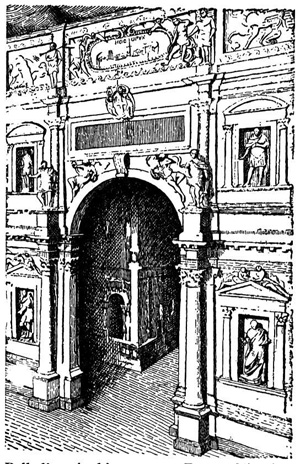

SPRINKLED OVER THE VENETIAN PLAIN are beautiful villas from the sixteenth to the eighteenth centuries. They’re the jewels of superstar Renaissance architect Andrea Palladio and his followers, which recall the symmetry and grace of Greek and Roman temples.
You can visit some of them pleasantly from Venice or Padua by taking a boat ride down the Brenta Canal, which stops at the waterway entrances to the villas and a restaurant for lunch. That’s a Golden Day right there.
But to get the full Palladio hit, go to the town of Vicenza. This is where Palladio was born, and it’s packed with his treasures, including the not-to-be-missed Teatro Olimpico.
A walk or short bus ride away from Vicenza’s historic center takes you to Palladio’s famous Villa Rotonda, and farther along a favorite of mine: the Villa Valmarana ai Nani. “Nani” means dwarves, and the name originated with this legend:
Once upon a time, a couple who lived in this villa gave birth to a daughter, who was a beautiful dwarf. Loving their child dearly, they wanted to protect her from feeling different, so they hired dwarf servants and kept her secluded in the villa and walled garden. For many years she was clueless and content, but when she was fifteen, she got curious about what was going on in the outside world. When her dwarf servants were sleeping, she climbed the stone wall, and up rode a handsome fellow on horseback. It was love at first sight for the dwarf-girl, but when she reached out to ride away with him into the sunset, for the first time she realized, “Oh no! I’m a dwarf!” Horrified, she hurled herself off the wall to her death. The servant dwarves heard her cries, woke up, and ran to find her. When they saw their dead mistress, they froze in grief.
That’s why you’ll see statues of seventeen nani atop the villa walls. They’re all inspired by Venetian Commedia dell’Arte characters—such as the Doctor, the King, the Knight, and the Turk. When Giustino Valmarana, a theater fan, moved here in 1720, he incorporated the nani story as part of his redesign.
The legend probably originated in the seventeenth century, when dwarves were popular characters in royal courts. They were perfect playmates for children, entertaining, and considered good luck tokens. Many were the result of inbreeding, and they were treated like pets, often given away by their mothers, as they weren’t considered part of the “real” family and wouldn’t be inheriting anything. Cruel, but true.
Once you’re past the nani and inside the walls, things get elegant: lovely gardens surround a foresteria (former farm-laborer’s place) and butter-yellow palazzina. Inside the little palazzo is where superstar painter Giambattista Tiepolo created some of the most stunning works of his career in the eighteenth century.
Tiepolo was a Venetian master of Rococo, who frescoed this place with theatrical gusto, finishing the palazzina interior in only four months. Using a dreamy pastel palate, he created breathtaking scenes from classical myths and legends.
When you enter, you’re hit with his Sacrifice of Iphigenia, which packs the power of an opera climax. Center stage sits the Greek warrior Agamemnon, pleading to the heavens for mercy as he holds a knife to his daughter Iphigenia’s chest. The story goes that Agamemnon ticked off the goddess Diana by bragging that he was a better hunter than she was. To punish him, she silenced the winds, screwing up his fleet. A prophet appeared to Agamemnon and said he’d have to sacrifice his daughter to lift Diana’s curse. In Tiepolo’s unusual happy-ending version of the story, Diana (on the ceiling) has a change of heart and flies in to substitute a sacrificial deer for Iphigenia. On the surrounding side panels, Tiepolo painted new winds blowing through.
Action-packed love scenes fill the adjoining rooms. There are images from “Orlando Furioso,” a Renaissance epic poem, where the gorgeous maiden Angelica makes Orlando absolutely furioso, because she can’t help but attract the attentions of other men.
In the Foresteria, which was a guesthouse, there’s one final Tiepolo masterpiece in the Olympus Room, where Venus is paired with her boyfriend Mars and Diana with Apollo.
The rest of the Foresteria was frescoed by Tiepolo’s son, Giandomenico, who moved on to realism and painted images from eighteenth-century life. There are scenes of peasants in the countryside, wealthy folks partying, a carnival—with both a monkey and an African servant serving chocolate!
Framed photographs of the Valmaranas, who still live here, are scattered about. One of their family’s twentieth-century heroines was Amalia, who was a mover and shaker in the Italian women’s movement after World War II. She helped to found the Catholic Centro Italiano Femminile, an organization that got women involved in the reconstruction of Italy, defending women’s rights and helping them get health care.
There’s a special charm to this small (for a villa) place that’s been in the same family for over three hundred years. The comical statues, colorful garden, sweeping frescos, and family photos blend with its exquisite design to make magic.
Villa Valmarana: open throughout the year, closed Mondays, but different days and times depending on the season. Check www.villavalmarana.com for up-to-date hours and prices.
How to get there: Trains from Venice leave often and take about 45 minutes. (www.trenitalia.it) Or rent a car, so you can explore the outskirts. (www.autoeurope.com)

Golden Day: Visit the Villa and enjoy Palladio’s masterpieces in Vicenza. For dinner, take a fifteen-minute drive to Caldogno and eat at Trattoria Molin Vecio (Via Giaroni 116, 0444 585 168, closed Tuesday, www.molinvecio.it). It’s built around a mill from 1520, surrounded by a lovely landscape and huge herb garden. Sleep at Hotel Campo Marzio (www.hotelcampomarzio.com), a boutique hotel close to the historic center.
TOURS
Boat tours of Italian villas are available from Venice or Padua at www.battellidelbrenta.it or www.ilburchiello.it.